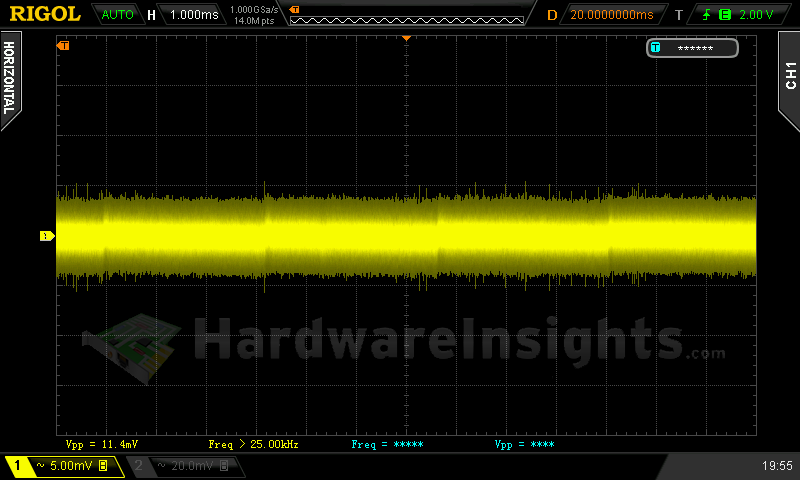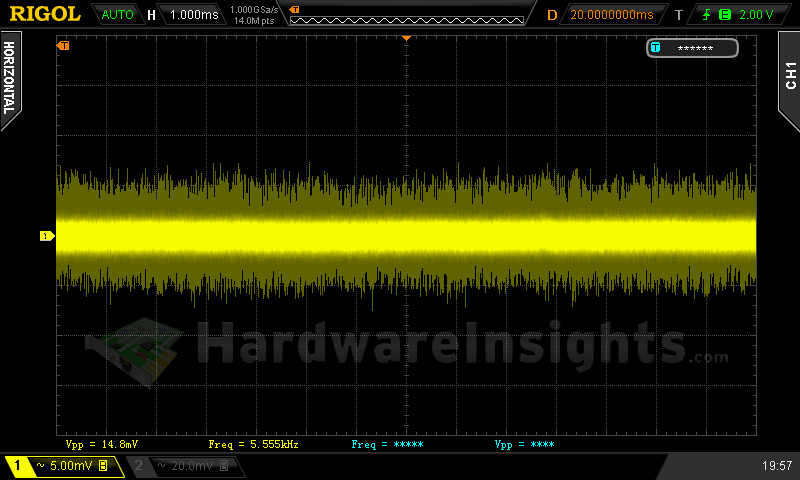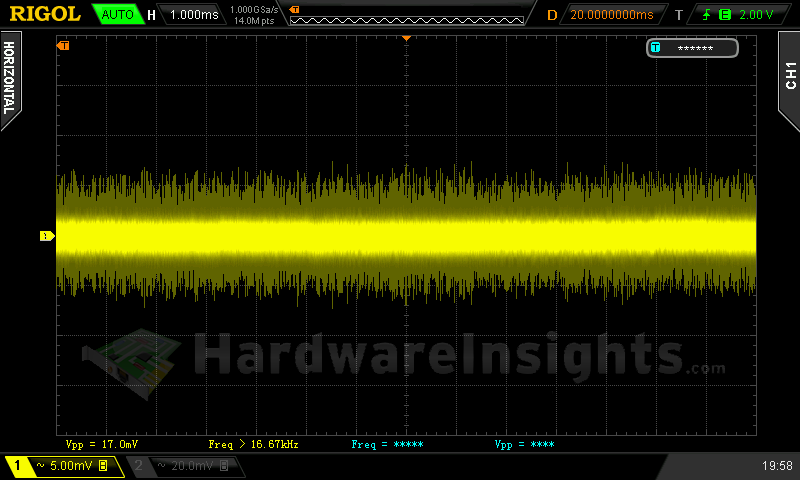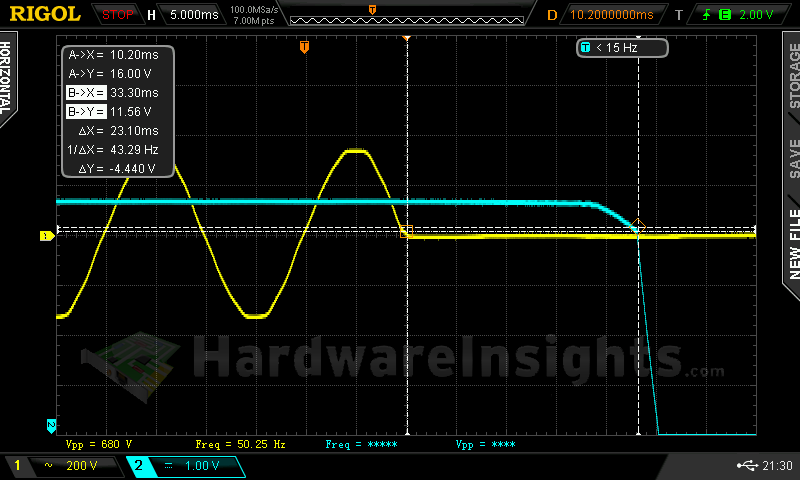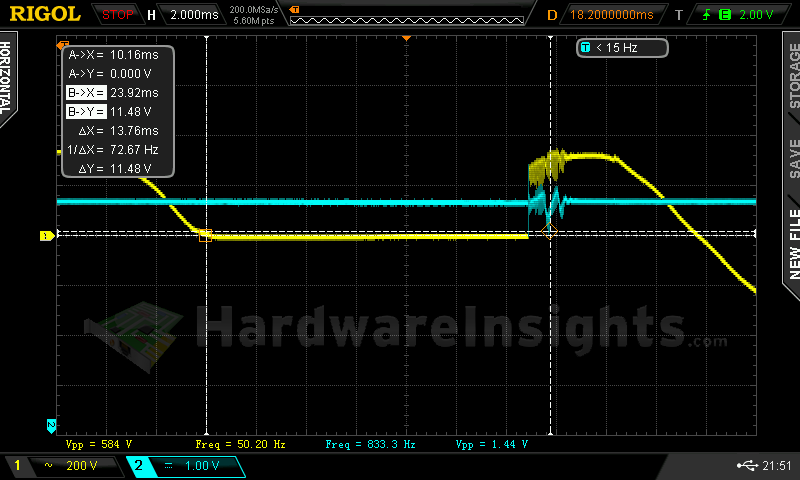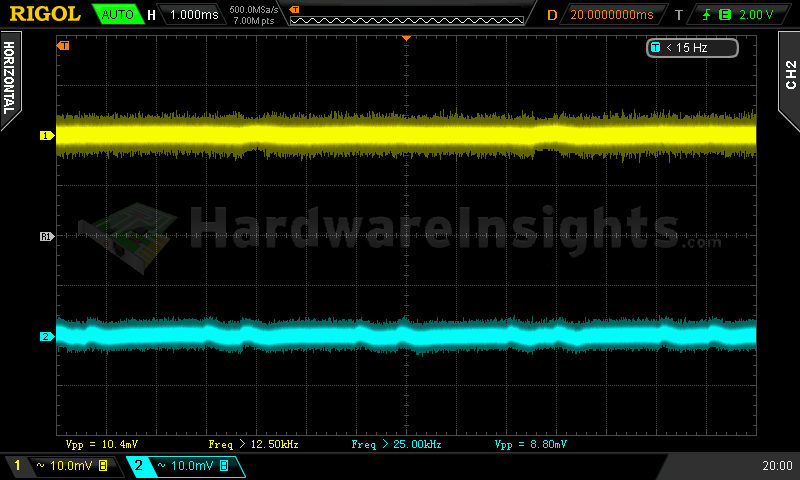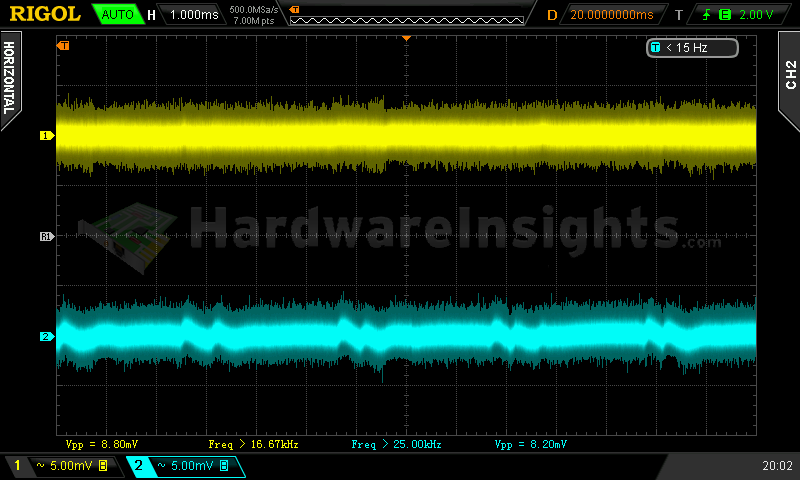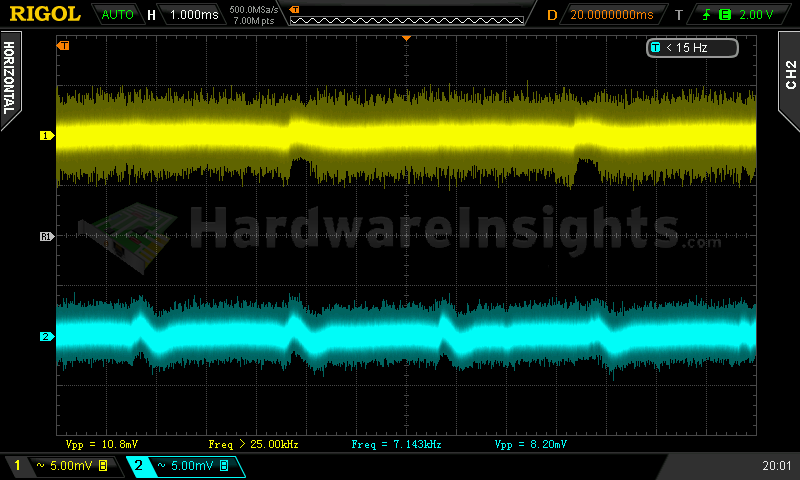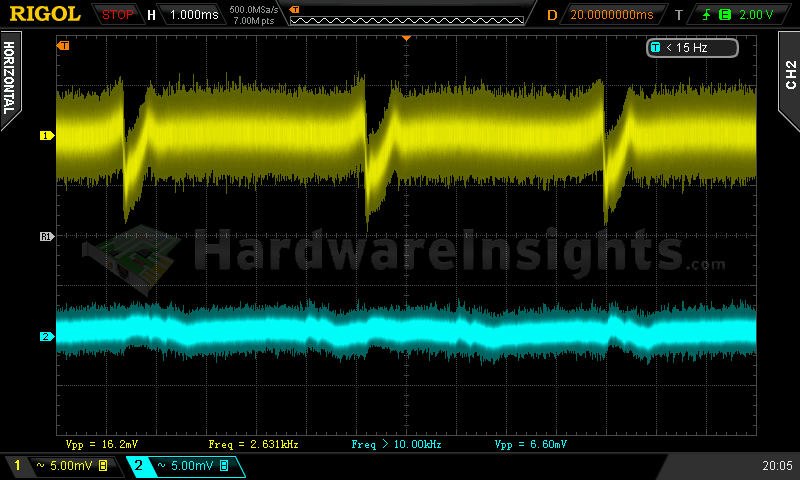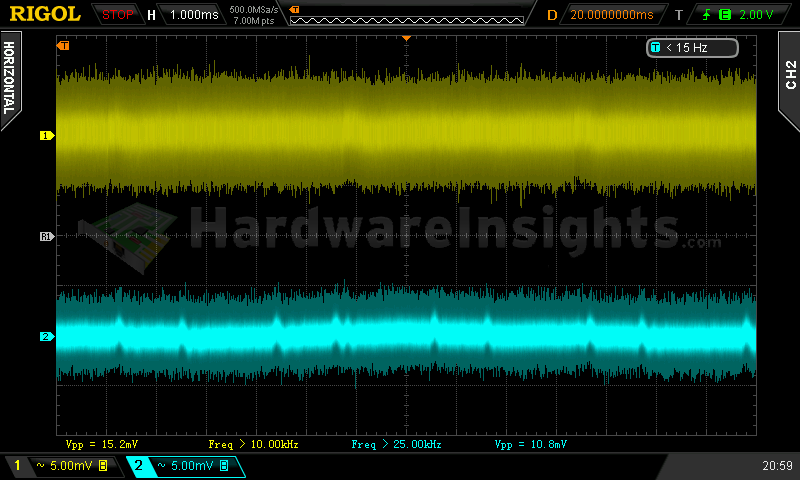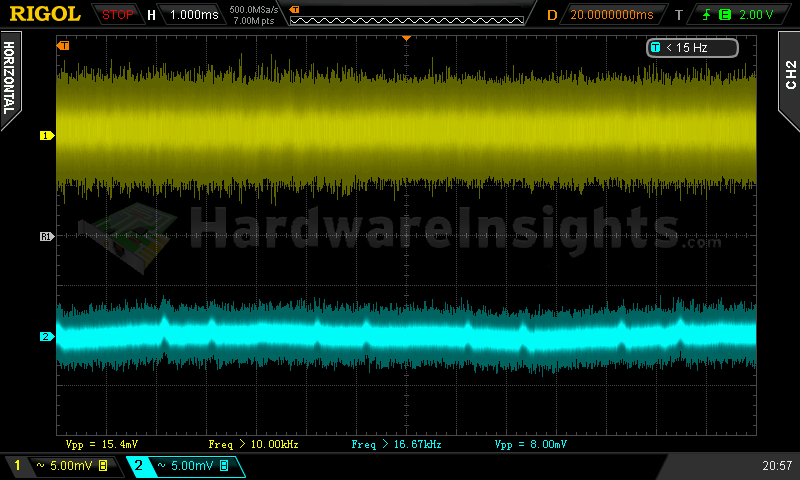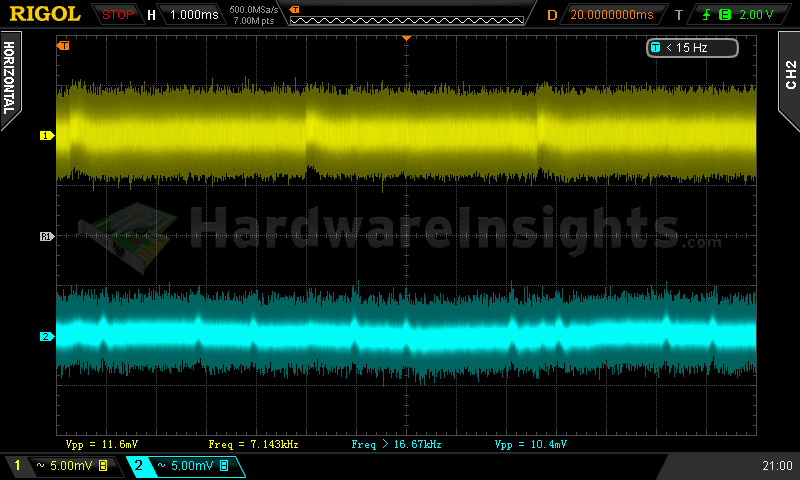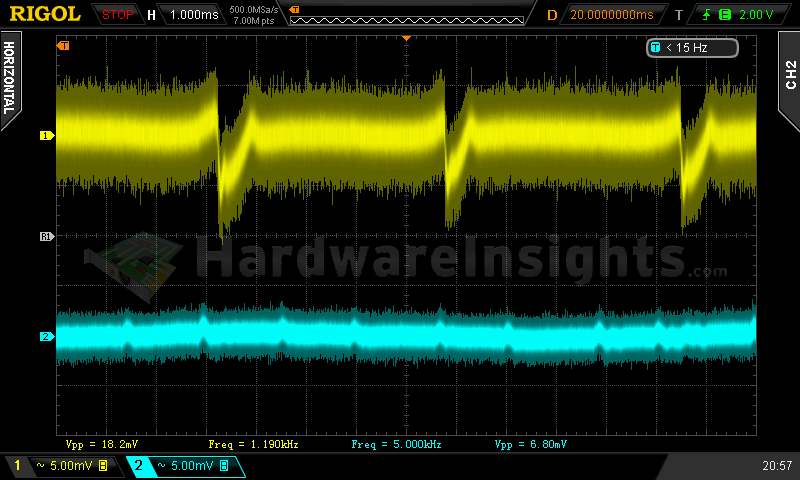Contents
- 1Introduction
- 1.1Packaging and accessories
- 2Connectors & cabling
- 2.1Casing & cooling
- 3Input filtering
- 4Primary side
- 4.1+5 V stand-by rail
- 5Secondary side
- 5.1Build quality
- 6Load testing
- 6.1Loading +5 V SB
- 6.2Voltage hold-up time
- 6.3Combined loading
- 6.4Combined loading ripple
- 6.5Crossloading, overloading
- 6.6Crossloading, overloading ripple
- 6.7Fan speed and temperatures
- 7Conclusion and evaluation
- 7.1Thanks
- 7.2Discussion
Load testing
Loading +5 V SB
As always, all load testing is done in accordance with our testing methodology. There just a small change, for now we have different wattmeter, the Electrobock EMF-1. Besides having resolution of 0.1 W, I think it is the same as all these cheap wall wattmetres. The voltage regulation is not bad, around one percent. On the other hand ripple suppression is below average. In spec, yes, but over 10 mV is nothing special, I gueess higher filtering capacity would help a bit. Efficiency is on the higher side, around 77 %, that is nice value.
| Output (W) | Load (A) | Voltage (V)/ ripple (mV) | Input (W) | Efficiency/power factor |
| 0 | 0 | 5.04/11.4 | 0 | —/0 |
| 14.20 | 2.86 | 4.97/14.8 | 18.2 | 78.0 %/0.40 |
| 16.42 | 3.31 | 4.96/17.0 | 21.2 | 77.4 %/0.44 |
+5 V SB ripple (left to right): 0 A; 2.86 A; 3.31 A
Voltage hold-up time
The hold-up time of the +12 V rail in the Corsair RM550x is OK, as we can see on the scope image, it is 23.1 ms. I would expect somewhat more though as the input capacitor has quite high capacity. Seems that the switching section is not that effective in using its stored energy.
Trying to interrupt the power for 23.1 ms revealed it is about that, 23.1 or 23.2 ms. That’s enough for the unit to handle properly working UPSes and their transfer times. There is already some not very nice oscillation where the lower side of the voltage touches ATX minimum of 11.4 V so I would not count with more than this time. Well, the input oscillates a bit as well as there have been some changes in the interrupter. The ATX PSUs, especially all those great Aurums with no thermistor, make so high transient loads they blew the power element in there (which was supposed to handle much greater spikes) so it has been made somewhat softer for it.
Combined loading
Combined loading was great. Lets talk about the voltage regulation first. All positive rails stood within ± 1 % regulation and the −12 V was within ± 2 %, but from ±10 % so it is like ± 1 % for the rest. This is just great. The +12 V rail itself never went under 12 V, that is very nice.
| Output power | Load/ voltage +5 V SB | Load/ voltage +3.3 V | Load/ voltage +5 V | Load/ voltage +12 V | Load/ voltage −12 V | Input power | Efficiency/power factor |
| 5.3 %/ 29.34 W | 0 A/ 4.99 V | 0.014 A/ 3.29 V | 0.410 A/ 4.99 V | 1.863 A/ 12.08 V | 0.394/ −12.16 V | 39.0 W | 75.2 %/ 0.64 |
| 20 %/ 103.12 W | 0.481 A/ 4.99 V | 4.473 A/ 3.30 V | 1.580 A/ 5.00 V | 7.15 A/ 12.08 V | 0.399/ −12.18 V | 120.9 W | 85.3 %/ 0.94 |
| 40 %/ 219.44 W | 0.96 A/ 4.99 V | 2.85 A/ 3.30 V | 3.43 A/ 5.00 V | 15.18 A/ 12.07 V | 0.400 A/ −12.20 V | 243.3 W | 90.2 %/ 0.97 |
| 60 %/ 326.15 W | 1.91 A/ 4.97 V | 4.48 A/ 3.30 V | 4.93 A/ 5.00 V | 22.6 A/ 12.05 V | 0.402 A/ −12.22 V | 361.8 W | 90.1 %/ 1 |
|
80 %/ 450.21 W |
2.50 A/ 4.97 V | 5.89 A/ 3.31 V | 6.09 A/ 5.01 V | 31.8 A/ 12.04 V | 0.402 A/ −12.22 V | 501.1 W | 89.8 %/ 0.99 |
| 100 %/ 545.99 W | 2.82 A/ 4.98 V | 8.86 A/ 3.32 V | 9.27 A/ 5.02 V | 37.5 A/ 12.03 V | 0.399 A/ −12.24 V | 615.8 W | 88.7 %/ 0.99 |
As for the efficiency, we will see in next review if the meter measures differently or not, for now the efficiency is about a percent (or percent and half) lower than I would expect. Than on the other hand it did not show any unbelievable figures so for now lets take it that the RM550x peaks slightly over 90 %. Low-load efficiency is quite low though. I think it is still nice. I have already selected entry-level professional power analyzer meant for SMPS, but it is already quite expensive device for me. Well, you can all donate after all…
Combined loading ripple
The ripple suppression of the Corsair RM550x is exceptional. Everything stayed under 20 mV and 40 %! The last such good results were from the Cooler Master V550S, that is already some time ago…
| Output % | Ripple +5 V SB | Ripple +3.3 V | Ripple +5 V | Ripple +12 V | Ripple −12 V |
| 5.3 | 10.4 mV | 8.8 mV | 10.8 mV | 8.8 mV | 16.2 mV |
| 20 | 14.6 mV | 9.2 mV | 15.4 mV | 5.6 mV | 17.4 mV |
| 40 | 16.0 mV | 13.8 mV | 15.2 mV | 6.8 mV | 13.4 mV |
| 60 | 17.0 mV | 10.6 mV | 16.2 mV | 7.2 mV | 15.4 mV |
| 80 | 15.0 mV | 10.2 mV | 15.2 mV | 7.2 mV | 15.8 mV |
| 100 | 15.2 mV | 15.4 mV | 11.6 mV | 10.8 mV | 18.2 mV |
Ripple 5.3% load (left to right): +5 V SB; +3.3 V; +5 V; −12 V . The second channel is connected to +12 V.
Ripple 100% load (left to right): +5 V SB; +3.3 V; +5 V; −12 V. The second channel is connected to +12 V.
Crossloading, overloading
Crossloading went good once again, as this is unit with DC-DC modules, I did not expect anything else. For that reason I even let sme rails with no load and the unit handled that well. The stand-by voltage dropped a bit but otherwise it was still very good regulation.
| Output power | Load/ voltage +5 V SB | Load/ voltage +3.3 V | Load/ voltage +5 V | Load/ voltage +12 V | Load/ voltage −12 V | Input power | Efficiency/power factor |
| 21 %/ 112.84 W | 0.479 A/ 5.00 V | 24.50 A/ 3.31 V | 0.416 A/ 5.01 V | 1.848 A/ 12.07 V | 0.406 A/ −12.22 V | 140.9 W | 80.1 %/ 0.94 |
| 28 %/ 154.77 W |
0.490 A/ 5.09 V | 0 A/ 3.31 V | 24.70 A/ 5.01 V | 1.858 A/ 12.07 V | 0.394 A/ −12.20 V | 192.8 W | 80.3 %/ 0.96 |
| 100 %/ 550.35 W | 0.487 A/ 5.02 V | 0 A/ 3.31 V | 0.405 A/ 5.02 V | 45.0 A/ 12.03 V | 0.404 A/ −12.23 V | 624.2 W | 88.2 %/ 1 |
| 123 %/ 673.86 W | 3.24 A/ 4.93 V | 5.56 A/ 3.32 V | 5.00 A/ 5.02 V | 50.7 A/ 12.02 V | 0.402 A/ −12.23 V | 763.2 W | 88.3 %/ 1 |
The efficiency is lower though, with +3.3 V and +5 V crossload it was just 80 %, then under +12V crossload it was better. I did not reach OCP limit on any rail, combined overload stopped slightly over 670 W. The unit worked fine while in sweater for 15 minutes, interestingly when I opened the sweater and measured the fan speed, it was still just around 900 RPM. Then I got tired of it, removed the sweater and stuck the fan. After that the RM550x turned off just a few seconds before five minutes.
Crossloading, overloading ripple
We finally exceeded 20mV on the −12 V rail but I think it is still great.
| Output % | Ripple +5 V SB | Ripple +3.3 V | Ripple +5 V | Ripple +12 V | Ripple −12 V |
| 21 | 19.2 mV | 20.0 mV | 19.2 mV | 15.2 mV | 24.8 mV |
| 28 | 18.6 mV | 13.2 mV | 20.0 mV | 10.4 mV | 18.2 mV |
| 100 | 11.0 mV | 11.8 mV | 10.8 mV | 14.0 mV | 16.4 mV |
| 123 | — | — | 15.0 mV | 13.6 mV | — |
Fan speed and temperatures
We got a new table! Since I got this nice laser tachometer toy (if only I knew how cheap and still precise this thingy is, I would get it much sooner), we can finally make a step towards getting more knowledge about the noise these power supplies make. Since noise depends on fan speed, we can now make much more educated guess whether some unit is silent or not, until I have the means to measure noise as well. And I think it was only logical to remove temperature figures from previous tables and include them here. Those ones are already overfilled and this one would be almost empty…
| Output % | Fan speed (RPM) | Temperature intake/ outtake |
| 5.3 | 0 | 21 °C/ — °C |
| 20 % | 0 | 21 °C/ — °C |
| 40 % | 0 | 22 °C/ — °C |
| 60 % | 604 | 23 °C/ 34 °C |
| 80 % | 610 | 23 °C/ 35 °C |
| 100 % | 675 | 23 °C/ 38 °C |
| CL 21 % | 986 | 22 °C/ 26 °C |
| CL 28 % | 1132 | 22 °C/ 32 °C |
| CL 100 % | 690 | 22 °C/ 42 °C |
| OL 123 % | 870 | 22 °C/ 39 °C |
So anyway, let’s get to the RM550x. We can see it was running fanless until test four, or more accurately, it started spinning somewhere around 320 W. I give 3 extra points for semi-passive operation. Well, that is kinda more than 225 W, that is nice. It seems it depends on temperature and it was quite cold around….the fan never crossed 700 RPM when it finally started. Under crossloading, it most likely started spinning faster by the end of +12 V rail crossload and continued to +5 V rail crossload, that is why it was spinning so fast. Also the efficiency was not really good.
